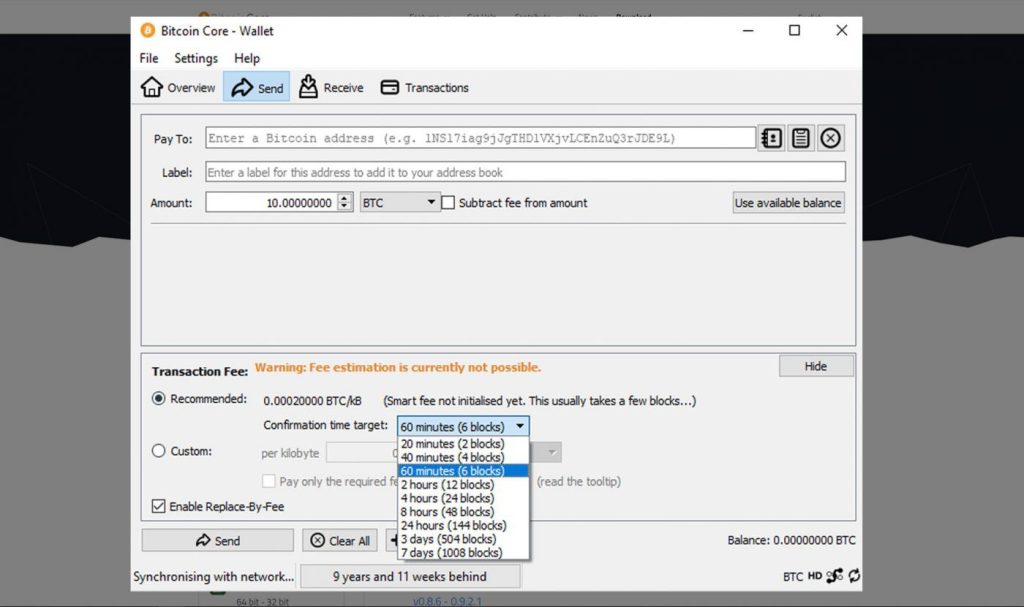Bitcoin Core is the official software client for the Bitcoin network. It allows you to run a full node, which means you contribute to the security and decentralization of the network while also having control over your Bitcoin transactions. Here’s a step-by-step guide on how to install and use Bitcoin Core:
1. Download and Install Bitcoin Core:
- Visit the official Bitcoin Core website (https://bitcoin.org/en/download) and download the version of Bitcoin Core that is compatible with your operating system (Windows, macOS, Linux).
- Follow the installation instructions provided for your specific operating system.
2. Initial Blockchain Download:
- When you first run Bitcoin Core, it will begin to download the entire Bitcoin blockchain, which is a record of all Bitcoin transactions. This process can take several hours or even days, as it involves downloading a significant amount of data.
3. Encrypt Your Wallet:
- After the blockchain is fully synchronized, it’s essential to encrypt your wallet to protect your funds. To do this, go to the “Settings” menu, select “Encrypt Wallet,” and follow the on-screen instructions to create a secure passphrase. Make sure to keep this passphrase in a safe place.
4. Backup Your Wallet:
- Regularly back up your Bitcoin Core wallet to prevent loss of funds. To do this, go to the “File” menu and select “Backup Wallet.” Save the backup file in a secure location, and consider using an offline storage method, such as a hardware wallet or a physical printout.
5. Send and Receive Bitcoin:
- To receive Bitcoin, you can generate a receiving address from the “Receive” tab in the Bitcoin Core wallet. Share this address with the person sending you Bitcoin.
- To send Bitcoin, go to the “Send” tab, enter the recipient’s Bitcoin address, specify the amount, and confirm the transaction. Remember to double-check the recipient’s address to avoid mistakes.
6. Transaction Confirmation:
- Bitcoin transactions are not immediately confirmed. It may take some time for your transactions to be added to a block on the blockchain. You can monitor the status of your transactions using the “Transactions” tab.
7. Security Considerations:
- Regularly update your Bitcoin Core software to the latest version to ensure you have the latest security improvements and bug fixes.
- Be cautious about online threats, such as phishing attacks, and use strong passwords for your wallet.
- Consider using a hardware wallet for added security when dealing with significant amounts of Bitcoin.
8. Full Node Operation:
- By running Bitcoin Core, you are operating a full node on the Bitcoin network, contributing to its decentralization and security. This comes with certain responsibilities, such as maintaining a good internet connection, sufficient storage space, and bandwidth.

Remember that using Bitcoin Core requires a good understanding of Bitcoin and the ability to manage your wallet securely. If you are new to Bitcoin, you may want to start with a user-friendly wallet that does not require you to run a full node. Additionally, always exercise caution and practice good security measures to protect your funds and privacy.
Bitcoin Core is often considered one of the most secure ways to use Bitcoin, primarily because it allows users to run a full node. Here are some reasons why Bitcoin Core is known for its security:
- Full Node Operation: Bitcoin Core allows you to run a full node, which means you download and validate the entire Bitcoin blockchain. This process ensures that you independently verify the rules of the Bitcoin network and are not reliant on third-party servers. By doing so, you contribute to the network’s security and decentralization.
- Self-Validation: With Bitcoin Core, you independently verify and validate every Bitcoin transaction and block, ensuring that you’re using a trustworthy and untampered version of the blockchain.
- Privacy: Bitcoin Core provides a high level of privacy, as you don’t need to rely on third-party servers to access your wallet or send transactions. This reduces the risk of data leaks and exposure to external entities.
- Security Updates: Bitcoin Core is actively maintained by a community of developers who continuously work to improve its security, fix vulnerabilities, and implement the latest best practices. Staying updated with the latest version of Bitcoin Core is crucial for maintaining security.
- Resilience to Network Attacks: By running a full node, you can independently verify the Bitcoin network’s rules and protect yourself from certain types of attacks, such as Sybil attacks and double-spend attempts.
However, it’s important to note that while Bitcoin Core offers a high level of security, it may not be suitable for all users. Here are some considerations:
- Resource Intensive: Running a full node with Bitcoin Core requires significant computational resources, including ample storage space, bandwidth, and processing power.
- Complexity: Bitcoin Core is not as user-friendly as some other Bitcoin wallets. It requires a good understanding of Bitcoin’s technical aspects.
- Initial Blockchain Download: The initial download of the entire Bitcoin blockchain can take a long time, particularly for users with slower internet connections.
- Backup and Security Responsibility: You are responsible for securely backing up your wallet and protecting your private keys and passphrase. Losing this information can result in the loss of your funds.
- Regular Maintenance: Keeping your Bitcoin Core software updated and properly configured requires ongoing attention and technical knowledge.
In summary, Bitcoin Core is indeed a secure option for using Bitcoin, especially for users who value full control, independence from third parties, and active participation in the Bitcoin network’s security. However, it may not be the best choice for everyone, as it can be resource-intensive and requires a good understanding of Bitcoin’s technical intricacies. Users should consider their specific needs and technical capabilities when selecting a Bitcoin wallet.
Shayne Heffernan









